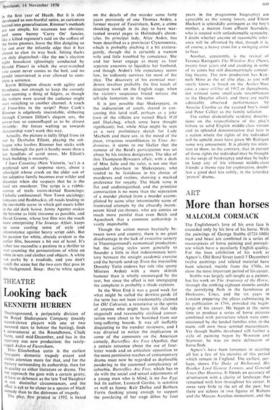ART
More than horses
MALCOLM CORMACK
The Englishman's love of his own face is exceeded only by his love of his horse. With the paintings of George Stubbs (1724-1806) man and beast are combined in a series of masterpieces of horse painting and portrait- ure which have a peculiarly English quality. For the loan exhibition of his work at Agnew's, Old Bond Street (until 5 December) twelve paintings and related material have been selected, mainly from the 1760s, to show the most important period of his career.
Stubbs was largely self-taught as a painter, but his work on The Anatomy of the Horse, through the stinking eighteen months amidst the putrefying flesh in the farmhouse at Horkstow, Lines, and the six years in London preparing the plates culminating in its publication in 1766, provided the begin- nings of his career. He began at the same time to produce a series of horse pictures combined with portraiture which were com- missioned by the landed families who, in the main, still own these seminal masterpieces. Yet though Stubbs developed still further a style of painting begun by Wootton and Seymour, he was no mere delineator of horse flesh.
Agnew's have been fortunate in securing all but a few of his pictui-es of this period which remain in England. The earliest, per- haps, shows The Duke of Richmond, His. Brother Lord George Lennox, and General Jones Out Hunting. It blends an accuracy of Oservation with a clarity of landscape that remained with him throughout his career. It owes very little to the art of the past: but there are echoes in two figures of Rubens and the Marcus Aurelius monument, and the
figures do not hang together in an overall composition.
Stubbs's individual sense of design is more apparent in this picture's companion from Goodwood, Racehorses belonging to the Duke of Richmond at Exercise. The red and yellow livery of the riders who gallop across the empty space of Goodwood Park are a lively piece of decoration, while the whole has Stubbs's slightly naive, open-eyed ob- servation and his accurate sense of pattern and relationships.
Basil Taylor's perceptive introduction to the catalogue draws attention to this careful feeling for design in The Grosvenor Hunt, beautifully cleaned for the exhibition. This masterpiece of 1762 embodies his increasing awareness of spatial harmony and all the freshness of his naturalism which was only rivalled by the early Gainsborough of Mr and Mrs Andrews.
The exhibition fortunately gathers together an impressive group of his horse designs— only one National Trust House was not will- ing to lend. These frieze-like designs are Stubbs's most impressive achievement in their balance of natural form and arabesque of profile and shape. Nothing like them exists in European art. They are more than por. traits of horses: their abstract qualities look forward to the twentieth century.
He was also capable of an intimate natural- ism, Huntsmen Setting Out From Southill, painted some time before 1768, has its indi- vidualised figures arranged against the village street seen truthfully, or as truthfully as was possible at that time in Europe. There is an intricate interlocking of forms and details which gives it a richness of texture and a variety of tonal relationships. What is un- usual is the leaning church tower. Did Stubbs use a camera obscura? His scientific bias may have interested him in its possibilities. It was left to the Romantic movement to develop the expressive qualities of such controlled realism.
After the 1760s Stubbs turned away from pictures based solely on horses. One later, more colourful, example of 1777 is included, but on the whole his patrons seem to have misunderstood his aims, apparently prefer- ring more specific portraits of themselves and their animals at some dramatic moment in contrast to the still world of Stubbs.









































 Previous page
Previous page